|
|
|
Sort Order |
|
|
|
Items / Page
|
|
|
|
|
|
|
| Srl | Item |
| 1 |
ID:
118376


|
|
|
|
|
| Publication |
2013.
|
| Summary/Abstract |
The Obama administration has made a great effort to increase the role of advanced conventional weaponry in US national security thinking and practice, in part to help reinvigorate the global nuclear disarmament agenda by reducing the role played by nuclear weapons in the US defense posture. However, such a strategy is fundamentally flawed because increases in US conventional superiority will exacerbate US relative strength vis-à-vis other powers, and therefore make the prospect of a nuclear weapon-free world seem less attractive to Washington's current and potential nuclear rivals. Consequently, it is highly likely that the impact of efforts to increase US advanced conventional superiority through ballistic missile defense and a conventional "prompt global strike" program will ensure that the Obama administration is adopting a pathway to nuclear abolition on which it is the sole traveler for the foreseeable future.
|
|
|
|
|
|
|
|
|
|
|
|
|
|
|
|
| 2 |
ID:
130558


|
|
|
| 3 |
ID:
150108
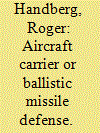

|
|
|
|
|
| Summary/Abstract |
Strategically, the United States is in a period characterized by uncertainty and diverse threats. Attempting to end two wars becomes background noise in the larger context of U.S. recalibration of its role in the world. U.S. power is perceived as either declining or being reoriented. Balancing off previous commitments with new ones becomes a critical and difficult task. The core problem becomes signaling commitment without deploying major forces to a particular location. Aircraft carriers are important symbolic instruments signaling U.S. interest regarding a particular issue. Those vessels are the linear descendants of battleships formerly the symbol of British power. Such deployments, however, are limited by being a ship, especially in disputes distant from the sea. Ballistic missile defense has come to occupy that role in signaling American commitment to allies or a state threatened by another. This can come as part of an alliance such as NATO's commitment of Patriot PAC-3 units to Turkey, with units drawn from three separate militaries including the United States.
|
|
|
|
|
|
|
|
|
|
|
|
|
|
|
|
| 4 |
ID:
128036
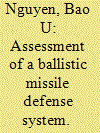

|
|
|
|
|
| Publication |
2014.
|
| Summary/Abstract |
This article presents a complete and self-contained analysis that assesses the effectiveness of a Ballistic Missile Defense System (BMDS). It does that by applying several techniques such as the properties of stochastic processes, the use of dynamical programing, the concept of generating functions and the applications of orbital mechanics. A step-by-step description starting from the computation of the number of engagement opportunities to the calculation of the probability of raid negation to the evaluation of the probability of integrated system effectiveness is introduced. The analysis also compares firing tactics in terms of effectiveness and inventory savings, assesses their contributions and limitations, as well as determines the driving parameters of a BMDS. New and optimal firing tactics based on more than one category of engagement opportunity are also described. The concept of redundancy and the possibility of boost-phase engagement are also explored in order to evaluate their impacts on the effectiveness of a BMDS.
|
|
|
|
|
|
|
|
|
|
|
|
|
|
|
|
| 5 |
ID:
156316
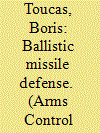

|
|
|
| 6 |
ID:
143302
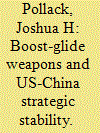

|
|
|
|
|
| Summary/Abstract |
The United States and China are testing boost-glide weapons, long-range strike systems capable of flying at Mach 5 or faster through the upper atmosphere. For the United States, these systems would provide a conventional prompt global strike capability, which, together with US ballistic missile defense programs, Chinese experts regard as a threat to China's ability to conduct nuclear retaliation. This perception is encouraging the Chinese military to modify its nuclear posture in ways that tend to create greater risks for both sides. If China's own boost-glide systems are meant to carry nuclear payloads only, their deployment would not fundamentally alter the current situation between the two states. However, if they were conventionally armed or dual-purpose, or if the United States could not determine the payloads they carried, the deployment of Chinese boost-glide systems could compound problems of strategic stability created by the introduction of ballistic missile defense, antisatellite, and antiship ballistic missile capabilities. If the technical hurdles can be overcome, it may be difficult for the two sides to refrain from these deployments in the absence of strong mutual trust or an established arms-control relationship. New confidence-building measures and expanded mutual transparency are warranted to avoid creating new dangers.
|
|
|
|
|
|
|
|
|
|
|
|
|
|
|
|
| 7 |
ID:
130518
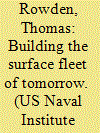

|
|
|
| 8 |
ID:
137279
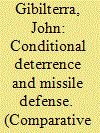

|
|
|
|
|
| Summary/Abstract |
The traditional view of ballistic missile defense is that defensive weapons are destabilizing. This article explains why the more broadly and traditionally accepted classical approach to deterrence is flawed and demonstrates the greater explanatory power and implications of conditional deterrence based on power parity theory. Given the implications that can be drawn from conditional deterrence, this article demonstrates that limited efforts at developing and deploying missile defenses enhance deterrence and reduce the ballistic missile threat in the short term and may also discourage the proliferation of ballistic missiles and weapons of mass destruction.
|
|
|
|
|
|
|
|
|
|
|
|
|
|
|
|
| 9 |
ID:
123123
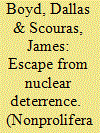

|
|
|
|
|
| Publication |
2013.
|
| Summary/Abstract |
Since the post-World War II genesis of nuclear deterrence, two presidential initiatives have been presented to deliver humanity from the threat of its failure. The first was the Strategic Defense Initiative (SDI), a constellation of space- and ground-based systems that President Ronald Reagan envisioned would render nuclear weapons "impotent and obsolete." The second is President Barack Obama's roadmap to "a world without nuclear weapons," commonly referred to as "Global Zero." While these proposals appear to have little in common, deeper investigation reveals a number of provocative similarities in motivation and presentation. Moreover, both generated fierce debate, often with ideological overtones, about their strategic desirability and technical feasibility. We use these parallels, as well as prominent dissimilarities, to draw lessons from the SDI experience that can be applied to the debate over Global Zero.
|
|
|
|
|
|
|
|
|
|
|
|
|
|
|
|
| 10 |
ID:
106266
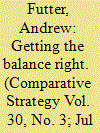

|
|
|
|
|
| Publication |
2011.
|
| Summary/Abstract |
Barack Obama has rightly embraced ballistic missile defense (BMD) as an important component of U.S. national security policy in an era where the requirements of nuclear deterrence are fluid and nuanced. Moreover, the deployment of these defenses may even provide several important benefits to the President's much-publicized nuclear nonproliferation and disarmament agenda. However, if the President's commitment to these goals is to remain credible and viable, then the importance of BMD against rogue states must be balanced with the need to avoid jeopardizing relations with key strategic competitors. As such, the President may have to limit U.S. BMD plans in the near future.
|
|
|
|
|
|
|
|
|
|
|
|
|
|
|
|
| 11 |
ID:
140972
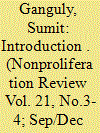

|
|
|
|
|
| Summary/Abstract |
The question of nuclear stability in South Asia is a subject of both academic and policy significance. It is the only region in the world that has three, contiguous nuclear-armed states: India, the People's Republic of China, and Pakistan. It is also freighted with unresolved border disputes. To compound matters, all three states are now modernizing their nuclear forces and have expressed scant interest in any form of regional arms control. These issues and developments constitute the basis of this special section, which explores the problems and prospects of nuclear crisis stability in the region.
|
|
|
|
|
|
|
|
|
|
|
|
|
|
|
|
| 12 |
ID:
140980


|
|
|
|
|
| Summary/Abstract |
Sixteen years after stepping out of the nuclear closet, India's nuclear posture, some of its operational practices, and hardware developments are beginning to mimic those of the original five nuclear weapon states. Several proliferation scholars in the United States contend that India's national security managers are poised to repeat the worst mistakes of the superpowers’ Cold War nuclear competition, with negative consequences for deterrence, crisis, and stability in South Asia and the Asia-Pacific region. This article takes a contrarian view. It dissects the best available data to show why the alarmist view is overstated. It argues that not only are the alarmists’ claims unsupported by evidence, their interpretation of the skeletal and often contradictory data threatens to construct the very threat they prophesize.
|
|
|
|
|
|
|
|
|
|
|
|
|
|
|
|
| 13 |
ID:
138803
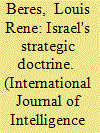

|
|
|
|
|
| Summary/Abstract |
If, as expected, Iran's ongoing nuclearization continues unimpaired, Israel will soon need to make certain basic revisions to its core strategic doctrine. These revisions would be substantially oriented toward enhancing the Jewish State's now-indispensable nuclear deterrence posture. Although largely counter-intuitive, such enhancement would actually require Israel to “disclose,” in carefully calculated increments, certain hitherto “ambiguous” aspects of the country's nuclear forces and infrastructures. In any such unique and unprecedented effort to systematically remove the “bomb from the basement,” major responsibilities for apprising political decisionmakers will fall upon the Israel Intelligence Community (IIC), most plainly MI (Military Intelligence, orAman) and the Israel Defense Force (IDF) Planning Branch. The IIC will need to be concerned with the following strategic doctrinal revisions.
|
|
|
|
|
|
|
|
|
|
|
|
|
|
|
|
| 14 |
ID:
111885
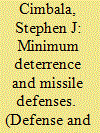

|
|
|
|
|
| Publication |
2012.
|
| Summary/Abstract |
Minimum deterrence is a compromise, or halfway house, between nuclear abolition or nearly zero and assured destruction, the dominant paradigm for strategic nuclear arms control during and after the cold war. Minimum deterrence as applied to the current relationship between the United States and Russia would require downsizing the numbers of operationally deployed long-range nuclear weapons to 1000, or fewer, on each side. More drastic bilateral Russian-American reductions would require the cooperation of other nuclear weapons states in making proportional reductions in their own arsenals. In addition, US plans for European-based and global missile defenses cause considerable angst in Russia and threaten to derail the Obama "reset" in Russian-American relations, despite the uncertainties about current and plausible future performances of missile defense technologies.
|
|
|
|
|
|
|
|
|
|
|
|
|
|
|
|
| 15 |
ID:
064225
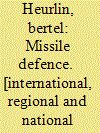

|
|
|
|
|
| Publication |
London, Routledge, 2005.
|
| Description |
xi, 227p.
|
| Standard Number |
0415361206
|
|
|
|
|
|
|
|
|
|
|
|
Copies: C:1/I:0,R:0,Q:0
Circulation
| Accession# | Call# | Current Location | Status | Policy | Location |
| 049859 | 358.174/HEU 049859 | Main | On Shelf | General | |
|
|
|
|
| 16 |
ID:
156084
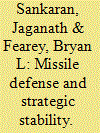

|
|
|
|
|
| Summary/Abstract |
South Korea is threatened by its troubled relationship with North Korea. North Korea possesses a large cache of missiles as well as chemical and biological weapons, and the future potential to mount nuclear weapons on its missiles. The United States is also challenged because of its defense commitments to Seoul. As a countermeasure, the United States and South Korea decided to deploy Terminal High Altitude Area Defense (THAAD) missile defenses in South Korea. However, China has objected. Chinese scholars believe the THAAD radar would be able to track Chinese inter-continental ballistic missiles, thereby weakening their deterrent. A technical analysis does not support this assertion. However, it is vital for South Korea, given its proximity and economic interdependence, to reassure China. South Korea should highlight that THAAD will be deployed by the United States Forces Korea and is not a commitment by Seoul to become part of U.S.-led missile defenses in the Asia-Pacific.
|
|
|
|
|
|
|
|
|
|
|
|
|
|
|
|
| 17 |
ID:
153509
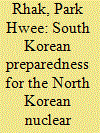

|
|
|
|
|
| Summary/Abstract |
This paper reviews the current state of South Korean nuclear preparedness and
draws out some necessary tasks for the future. It reviews all available options that a
non-nuclear, threatened country should take in response to the level of the nuclear
threat. These are a diplomatic approach, a preventive strike, deterrence, defense,
civil defense, and negotiations. In conclusion, South Korea has depended too much
on diplomatic solutions in the initial periods of the North Korean nuclear weapons
development. It did not review defense measures in depth and did not consider
the preventive strike option during that period. South Korea procrastinated on its
Ballistic Missile Defense (BMD) construction and did not review the necessity of
nuclear civil defense until the present. South Korean nuclear preparedness appears
to have many shortcomings. South Korea should expedite and improve its BMD
shield as soon as possible. It may need to utilize the preemptive strike capabilities of
the United States to provide more money for its BMD. It needs to prepare nuclear
blast and/or fall-out shelters by efficiently renovating existing conventional shelters
and other underground facilities.
|
|
|
|
|
|
|
|
|
|
|
|
|
|
|
|
| 18 |
ID:
115533


|
|
|
| 19 |
ID:
130343


|
|
|
| 20 |
ID:
137938
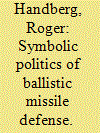

|
|
|
|
|
| Summary/Abstract |
Ballistic missile defense (BMD) politics present an interesting evolution in how the USA, especially Congress, has come to think about BMD both as operational reality and as a symbolic policy. The argument here is that BMD’s operational reality is increasingly overshadowed by its symbolic aspects. Such a status arose from rapidly changing international and domestic politics. The end result is a situation in which BMD policy in a sense floats above the question of its actual combat effectiveness. Its primary mission in part is sustaining US capacity to remain a global power and support its allies.
|
|
|
|
|
|
|
|
|
|
|
|
|
|
|
|
|
|
|
|
|